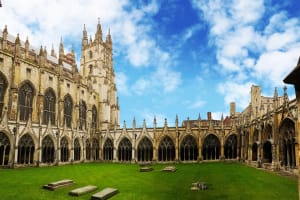
St. Augustine's Abbey was a Benedictine monastery in Canterbury, England. It was founded in the early 7th century by St. Augustine of Canterbury and was dedicated to Saints Peter and Paul. The abbey played an important role in the spread of Christianity in England, and it was one of the most significant religious centers in the country until it was dissolved in 1538 during the English Reformation.
The abbey was established by St. Augustine shortly after he arrived in England in AD 597 as a mission sent by Pope Gregory I. The original buildings were constructed from wattle and daub, but they were later replaced with stone structures. The abbey was destroyed by the Danes in the 9th century and was rebuilt in the 11th century by the Normans.
The abbey church was a notable example of Norman architecture, and it was the site of many important events in English history, including the coronation of William the Conqueror in 1066. The abbey also had a substantial library, and it was home to many important works of literature and art.
After the dissolution of the monasteries, the abbey was partially dismantled and its buildings were sold off. Some of the stonework was used to construct other buildings in Canterbury, including the city walls. Today, only ruins remain of the once-great abbey, but it is still a popular tourist attraction and an important historical site. The ruins are now part of the St. Augustine's Abbey World Heritage Site, which also includes Canterbury Cathedral and St. Martin's Church.
Explore Near St Augustine's Abbey
Discover 5 attractions, 5 cities, and 1 airport within 75km. Perfect for planning day trips, finding connecting flights, or discovering new destinations to explore during your visit.
Nearby Attractions & Places to Visit
5 destinations within 295m - 25.0km from your location





Nearby Cities Worth Exploring
5 destinations within 499m - 24.9km from your location
Airports Near St Augustine's Abbey
1 destination within 42.4km from your location
Cross-Border Adventures Near St Augustine's Abbey
Discover cross-border adventures near St Augustine's Abbey. Explore neighboring countries with similar attractions and extend your travel experience across borders.
